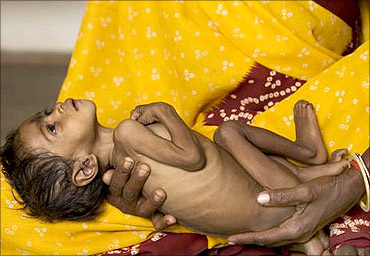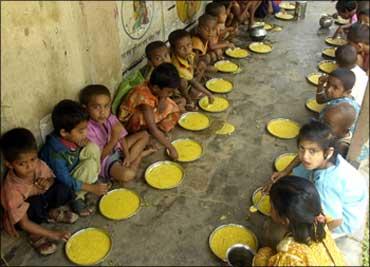Photographs: Courtesy, UNICEF.
"You can't have two Indias. What is this stark contradiction in our whole approach in eradication of malnutrition. You say you are a powerful country but at the same time, starvation deaths are taking place in various parts of the country. It (malnutrition) must be totally eliminated and eradicated," the bench told additional solicitor General Mohan Parasaran.
There can't be two Indias, SC tells govt
Image: Students have a free meal distributed by a government-run school in Nalchar village, near Agartala.Photographs: Jayanta Dey/Reuters.
The apex court wondered what was the logic in the government claiming that there were adequate food grains in the country when thousands of people are dying on account of starvation.
The bench made the scathing observations as Parasaran sought to explain that the government was determined to reduce the malnutrition problem and streamline the Public Distribution System and that malnutrition is coming down. "What do you mean by coming down? It must be eradicated," the bench remarked. The apex court cited newspaper reports that the country was witnessing bumper crops and the godowns were overflowing with grains.
There can't be two Indias, SC tells govt
Image: Sushila, who weighs 4.5 kg and suffers from severe malnutrition, sits in her mother's lap.Photographs: Reinhard Krause/Reuters.
The bench made the critical remarks while dealing with a PIL filed by Peoples Union for Civil Liberties (PUCL) complaining about large scale corruption and irregularities in the PDS mechanism of the country.
Questioning the plan panel rational in fixing 36 percent as the percentage of BPL families in the country, the bench said, "It is astonishing as to how you can fix 36 per cent people in the BPL category in 2011 by relying on the 1991 census data."
There can't be two Indias, SC tells govt
Image: Poor people in India.Photographs: Reuters.
The apex court noted that a number of states including those ruled by the Congress have filed their affidavits insisting that the BPL percentage is much more that the 36 per cent fixed by the Commission and had sought more food grains for distribution among the BPL and APL families.
"How can you fix such a limit when the per capita income varies from state to state?" the bench said.






article